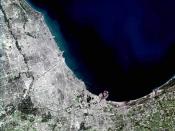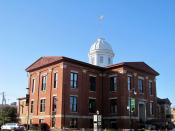Samuel and Margaret Gillian are considered the first white people to settle in what is now McHenry County. Prior to their arrival on November 18, 1834, Samuel Gillian was a farmer from West Virginia. On an attempt to move westward, he first moved to Champaign County, Ohio, where he remained for approximately a year. As his quest for a permanent settlement continued, he came upon the city of Chicago. Although fascinated with the mass population and varied activities, Gillian, along with his wife and eight children, were pursuing unsettled land. While traveling Northwest over an ocean of prairie, they reached the banks of the Fox River. With it's high bluffs and deep valleys, the area also was home to such game as deer, lynx, and wolves. Not knowing of the Indian settlement already along the banks, the Gillians settled in this location.
The first year on the banks of the Fox River was tough.
The Gillians faced unrest with the Indians who lingered around, their first corn crop was lost due to illness, and the death of their eldest daughter left the family mourning. Although the hardships, Samuel Gillian continued to live with his claim until his death in 1837.
The year was 1835, and already two separate colonies had developed; Virginia Colony, located in what is now Dorr County, and Pleasant Grove Colony, which is now called Marengo.
As a large population of immigrants migrated here from Virginia, settlers from that area came and lived amongst each other and hence, came up with the name Virginia Colony. Out of this settlement grew the village of Ridgefield.
Calvin Spencer, noted for staking claim in Crystal Lake, was also the first settler in the Pleasant Colony. Just as Spencer arrived, it wasn't long until the colony populated a dozen people.
Although claiming land in this area, it was a common procedure for men and their families to spend most of their winter in Chicago. The development of Chicago back then provided new settlers relief from having a food shortage or sudden mishap during the long, harsh winters.
The advantage of having wood and water were of prime importance to the settlers. The area of McHenry county yielded rich soil good for planting, along with an abundant amount of trees which the settlers used as a means for building houses, fences and fuel. What more appealing to the settlers, this area had a plentiful amount of strong wood (oak, hickory, etc.) which lasted a long time with out the need for much repair.
Ideal water for the settlers would have been swift, flowing rivers, but the well watered area with many lakes ponds and small rivers suited early settlers fine.
Because roads didn't come into the historical perspective for a long time, the many small rivers served as not only a watering hole, but also a means of transportation for the many industries which sprung up along the banks of the Fox River.
As new settlers arrived in this area, they found mostly prairie land housing tall buffalo grass which the new people didn't know how to deal with. Initial avoidance to the six to seven foot grasses found the settlers running out of space to farm their crops. Painstakingly, the early settlers cleared the land and built their homes. As time passed, people found out the richness of the prairie soil and also found ways to use the tall grass to cut down. For instance, tall buffalo grass provided excellent grazing land in winter seasons.
As early farmers impudently scattered their cereals across the prairie soil, they soon found out that the land appealed to the variety of grains which the settlers were used to in the east. Such crops as corn, oat, and wheat grew beautifully with the help of the adequate amount of rainfall in the region. This principle occupation soon provided the settlers with a comfortable life.
Before the massive migration to the area during the late 1830s and early 1840s, the earliest settlers were blessed with plentiful game along the rolling meadows and in the deeps of the rivers and lakes. Such animals as the deer, bears, and elk just roamed the wooded areas as did small mammals and birds in the prairie. Along the banks of the river and in the streams, settlers found a plentiful amount of fish. During the early years of the settlers (before their first harvest), many families literally 'lived off the country.'
Many of the immigrants who moved here were from New England, Virginia, and New York. Along with the immigrants came different customs. For instance, in 1838, a New Yorker by the name of Mr. Easton was credited with for planting many of the fruit trees seen in McHenry County today. It was the norm for New Yorkers to bring with them a small nursery since they were accustomed to this kind of vegetation.
Another thing brought over here from the East was religion, which played a major part in the lives of early settlers. Illiteracy, poverty, and self confidence were all things which the church restored into the community. Although Baptist was the initial form of Christianity, Catholics, Methodists, Presbyterians, Lutherans, and Episcopalians soon increased in number and popularity. Churches which used to be conducted in residential houses, were now conducted in their own buildings, and schools soon branched out from the religious base the church filled.
The church organized such activities as house raising, log rolling, wild hunts, and wrestling matches to unite the community together. Such things as singing groups, and various clubs also developed. With such activities, McHenry County held it's first fair in 1859.
As settlements grew, one noticed an interesting chain of similarities among each one. It seemed as though new immigrants were not only looking for the perfect physical aspects of the land, but also looking to move near neighbors of the same cultural background. This was true. In order to be more comfortable and less lonely, settlers went toward what was familiar with them; and that was two things, the church and people of similar backgrounds.
As time passed, farmers learned to live with the prairie and to use it's soil in good wealth. It was because the absence of mineral wealth that the people concentrated so greatly on the yearly harvest. Wheat and other grains were all sowed by hand then planted through wooden harrows in the land. As the yearly harvests grew more plentiful and planted methods became more easier, farmers saw a profitable market grow. Although most couldn't reach large markets, which were in Chicago, the farmers held local market. Most preferred to sell locally because a trip down to the city usually took about three days and a farmer was guaranteed a lower price per bushel due to competition. It wasn't worth going down to sell until the development of the rail system in 1854.
After the development of the rail system, things changed. Not only was it one of the first signs of major development, but it also helped industrial advertisement. It was because of this that the first industries were made. Most relating to farming, it was a very profitable business; however, it was a short-lived venture.
One of the earliest businesses in the county was that of cheese making. Within a two year span, three cheese factories sprung up in the county. The first being that of Dr. R. R. Stone and Willian A. McConnell in Richmond. Of the other two, one was located in Hebron, the other in Huntley. The success of this industry brought approximately fifty-three cheese and creameries by 1884. In addition to the number of factories, a large number of private farmers made their own cheese at their home with their cows. The industry was on a decline until the introductions of McHenry County's 'filled cheese.' This cheese was made from skim milk filled with lard. This product helped 'restart' the cheese industry in McHenry County.
In an attempt to add on to the already successful cheese industry, dairymen started to ship out whole milk into the city. The dependency of Chicago to McHenry County's milk resulted in two things: a daily supply of whole milk into the city by rail, and the development of the big companies constructing milk making plants in the county. Borden built the first milk receiving plant in Hebron in 1902; the plant continued operation until the 1960s.
The dairy industry grew so quickly that it branched off into many sub-industries (i.e. cheese making, milk making, etc.). One particular branch of the dairy industry was the production of butter. It is recorded that during the Philadelphia Centennial Exposition, a Mr. J. S. Watrous, of the Nunda Township, entered his butter, made at the Ridgefield Crystal Spring Factory. Due to the quality of the butter, taste, and appearance, he was awarded the gold medal. This is particularly interesting because of the fact that this exposition included professional farmers from the more developed east coast and also Canada. This source of pride and inspiration caused instant fame for the industry.
It was the years through the 1840s into the early 50s that this area saw the largest change. The census of 1850 showed a drastic increase in population to 14,978. This mass migration caused a demand to better commerce. This call lured two men: Benjamin Douglas and Colonel Hoffman. Within this partnership, the two built McHenry County's first saw mill in 1839 in Crystal Lake, just three quarters of a mile near the lake.
It was a Mr. C. S. Dole, a cattleman who kept thoroughbred stock, who was the one to first start the ice selling business. He found mass profit in filling his icehouses with crystal clear ice from Crystal Lake in the winter, and shipping them to Chicago in the summer months.
In the years of 1854 through 1856, McHenry County was blessed to receive it's most significant economic development of the area. It was a man of the name William Ogden who moved to Chicago from New York in 1836 to look over land which his uncle had bought. Although he became wealthy selling the land, he had a dream of connecting the city of Chicago with other parts of the county by rail. Because the business community didn't share his dream, Ogden set out on buggy trying to raise money for the funding of the rail.
Ogden went door to door offering farmers and their wives shares of the stock for only a few dollars. He even offered a chance to 'pay later when your money from your crops come in.' Finally, enough stock was brought to start the production of the Galena and Chicago Union Railroad. Within two years, the monthly income of $2000 a month jumped to $9000. Farmers who had bought shares became very wealthy men, and this new connection between McHenry County and the city made shipping grains prosper.
By, Don Cook
By, Don Cook


